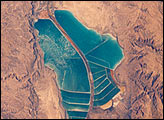
Locality 1
Modern Example
Dead Sea
Dead Sea is a large perennial saline lake in a rift valley more than 400m below sea level and fed predominantly by the River Jordan. It is the only recent analogue of ancient deep evaporites, but evaporite are currently not the predominant sediment present and the composition of its brine differs comparably from that of sea water.

source http://visibleearth.nasa.gov/
Satellite image of the Dead Sea
The lake is divided into two distinct different basins:
The predominant sediment in the Dead Sea basin is clayey silt. Evaporite minerals include
Aragonite needles precipitates from white sediment laminae alternating with detrital laminae. Gypsum occurs as hard layers of lenticular crystals, as crystal clusters, but predominantly as dispersed isolated crystals. Halite, other than a shallow-water halite slush in shallow southern basin, never constitutes more than 10% of the bottom sediment and is present as disseminated cubic crystals and as crystalline blocks.
Prior to 1979 evaporation during the summer months concentrated the surficial part of the upper, more dilute water mass. Aragonite and to a lesser extent, gypsum and halite crystals precipitated at the surface and settled through the undersaturated upper water mass. Brines are now precipitating salts, mostly at the lake edge, but also in the lake interior (Reading, 1996).
This page was created by Pamela Williams
Last Modified:18/06/02